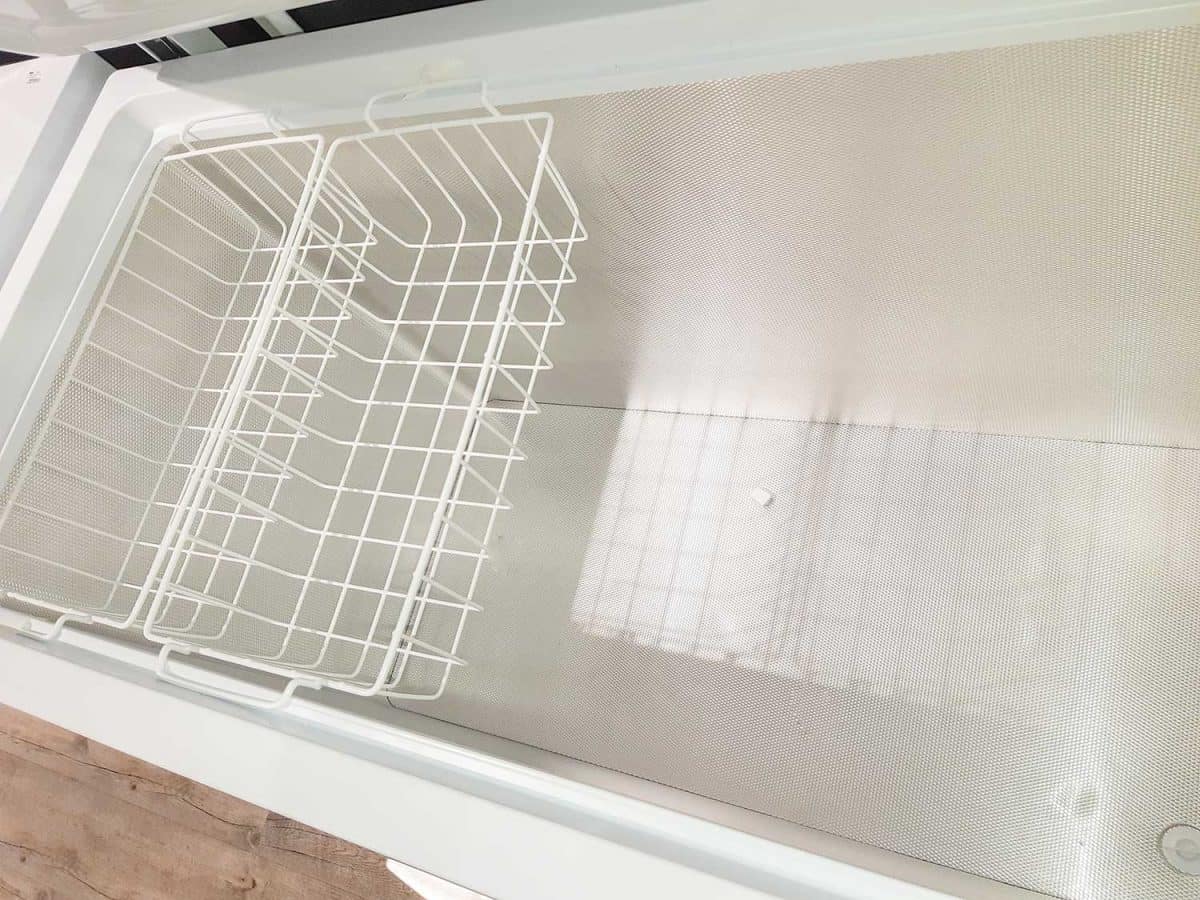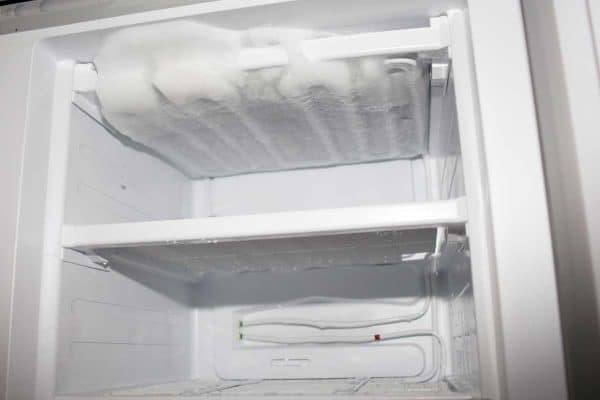Are you tired of the recurring ice buildup in your chest freezer? We feel the same. So, we scoured the internet to find the best methods to prevent frost formation in your chest freezer.
Preventing your chest freezer from often freezing up does not require hiring and paying a technician. The solutions to the cold situation are simple and as follows:
- Reduce warm air intrusion.
- Stock goods the right way.
- Cool down foods before storing them in the freezer.
- Keep the freezer temperature ideal.
- Ensure the freezer completely seals.
All it takes is a bit of your effort, and you can already prevent ice buildup in your chest freezer. You may already have intuitively known what to do in each of the solutions. But some of them require more than intuition. Read further to avoid messing up some of them. And don’t miss out on the tips to get rid of the ice buildup as well.
NOTE: WE MAY GET A COMMISSION IF YOU DECIDE TO MAKE A PURCHASE THROUGH THESE LINKS. THERE'S ADDITIONAL NO COST TO YOU. CHECK THE BOTTOM OF THE PAGE FOR MORE INFORMATION.

preventing ice buildup in the chest freezer
As a quick guide, here's a video of how you can prevent chest freezers from forming frost:
Now, let’s dig deeper into more detailed ways of preventing your chest freezer from freezing over.
Reduce warm air intrusion
Warm air is the top reason why chest freezers and other freezers build up frost quickly. When you frequently open your chest freezer for long periods, the cold air escapes, and hot, humid air intrudes the freezer.
Humidity introduces moisture to the freezer and turns into frost. And the warmth it brings causes the freezer’s temperature to rise, which makes the compressor work double the amount it does to keep the goods frozen.
Avoid this by lessening unnecessary freezer visits and reducing the time you keep the freezer door open. Organize your goods in a way that you can quickly pick the food you want to cook. Labeling and sorting them out based on usage dates can drastically help decrease the time you keep the freezer door open as well.
Stock goods the right way

Observing proper food storage in the right amount may not seem a good piece of advice at first, but you will be surprised by how much this will improve the condition of your chest freezer.
Experts recommend storing between 2 and 3 pounds of food per one cubic meter of the chest freezer compartment. Stuffing in any more than that amount can overload and pop the freezer, resulting in frost. On the same note, leaving it almost empty can also freeze up the compartment. So keep the food content around the ideal amount.
Also, correct freezer storage practices can further limit the possibility of frost formation and keep your food from going bland.
We recommend you store your goods in smaller portions as this minimizes air in the appliance. Cut big meats into sizeable dimensions and package them into storage containers. If you’re using freezer-storage bags, suck as much air out to avoid freezer burn.
Cool down foods before storing them in the freezer
If you are freezing leftovers, always wait for the food to cool down. Putting warm food in the freezer right away introduces both heat and moisture to the compartment, which, as mentioned earlier, is the top culprit for causing frost buildup.
The steam coming from any warm or hot food turns to frost fast. So remember to wait for the food to reach room temperature. Then, place it in the freezer for a few minutes to further bring down the temperature.
Keep the freezer temperature ideal

Maintaining the temperature inside the freezer compartment is the core of our ice buildup prevention efforts. But the ambient environment where your freezer is also plays a role. In other words, you should complement the interior and exterior temperatures.
For the interior, set the temperature to the lowest possible, around 0 degrees Fahrenheit (-18 degrees Celsius). This way, you can both keep an ideal freezing environment for your goods and avoid ice accumulation. Putting a thermometer inside the freezer can help with your monitoring, which you should conduct monthly.
For the exterior, ensure that you keep your freezer in an environment with low humidity. The ambient temperature in the surroundings of the freezer affects the condition inside the compartment.
A hot environment only results in frost buildup because it makes the chest freezer work harder to keep the temperature inside steady. Observe proper air clearance around the freezer, especially the back and sides.
Chest freezers require at least 3 inches of air clearance on all sides to enable healthy air circulation for the freezer compressor to cool down. Not giving this enough space can result in frequent temperature fluctuation and moisture or condensation problems.
That’s why you should put your chest freezer in a well-insulated area in your home, like the basement or the garage.
Ensure the freezer Door completely seals
Lastly, the simplest way to prevent frost buildup is to check if the gasket on the freezer is still able to seal the air inside. You can check this using three methods: paper, flashlight, and hand tests.
Freezer door seals are magnetic strips, so they can come undone as time passes and may result in failure after performing the tests.
Luckily for you, remagnetizing them can bring the seal back. You should just run a neodymium magnet on the gasket 50 times to “recharge” the magnetic strips. But only use this method when you are 100% sure the freezer door is not locking in the cold air due to demagnetized strips.
You can also reseal the gasket if demagnetization is not the problem. With simple cleanup and re-moisturization using petroleum jelly, you can bring back the sealing strength of the gasket. Reheating the strips using a hairdryer will also do the trick.
Why does ice build up in the chest freezer?
Chest freezers are like most home appliances, after incorrect usage, it starts to act up through ice buildup. Essentially, they start to form ice when they are too old or when the compressor is working harder to regulate the temperature inside the freezer. When either of these conditions is present, you will notice that the sides of the chest freezer feel hotter to the touch.
This makes the temperature inside the freezer fluctuate and become inconsistent. The result? The appliance uses up all its capability to reach the freezing temperature to preserve the foods inside, causing freezer burn and frost buildup.
Is ice buildup in the chest freezer bad?
Yes, the persistent occurrence of ice buildup is not a good sign. It can certainly mean that your chest freezer may already be undergoing drastic changes.
This can also indicate that your chest freezer’s temperature regulator is starting to go out of control due to old age. If it continues to happen, your food’s flavor, texture, and aroma of the food products will be compromised.
How do I get rid of excess ice in my deep freezer?
Often, you do not need to despair when frost becomes prevalent inside your chest freezer. Here are ways to stop it on its track and keep your food safe:
- Empty your chest freezer and transfer your foods to the fridge. Throw out spoiled foods.
- Meanwhile, boil a saucepan of water, which you will need later in steps 4 to 6.
- Unplug the chest freezer and wait for a few minutes until the ice melts.
- Layer a thick cloth inside the compartment and leave the hot saucepan of water inside the freezer for 10 minutes.
- After the time elapsed, scrape the stubborn frost with an ice scraper, wooden spoon, or spatula. Do this gently to avoid damaging the interior walls.
- If there is remaining ice, immerse a towel in warm water and start wiping the ice way away.
- Keep the freezer open until it dries. And you’re done getting rid of the excess ice in your deep freezer.
How do I stop my chest freezer from icing up?

If the chest freezer immediately starts to form frost again a few hours after getting rid of them, deeper problems are at play in the freezer system. Drastic measures are in order.
The advice we can give you in stopping your chest freezer from icing up is to always conduct periodic maintenance checkups, especially on the compressor and temperature regulator. You can manage this problem using the following steps:
- Unplug the chest freezer and keep the door closed to keep the cold air during your maintenance check.
- Remove the service panel cover at the side or bottom part of the chest freezer.
- Access and unfreeze the drain line.
- Use the catch pan and a towel to remove the melted ice from standing below the drain line.
- Vacuum the coil and condenser fan to remove accumulated grime and dust that may be blocking the airflow.
- Brush away remaining dust to completely unclog the airways.
- Using a damp towel, wipe the coils one last time, and then put back the covers.
In summary
Frost in the chest freezer can be annoying in many ways. It takes the space intended for your goods, not to mention they increase the possibility of freezer burn. Fortunately, by following a few simple steps, such as keeping it close to maintain the ideal freezing temperature and packaging your foods the right way to reduce moisture and air, you can prevent ice buildup.



![Woman hand open plastic white container drawer in new refrigerator. How To Put A Freezer Drawer Back In [Inc. For Specific Brands]](https://forfreezing.com/wp-content/uploads/2021/09/Woman-hand-open-plastic-white-container-drawer-in-new-refrigerator.-How-To-Put-A-Freezer-Drawer-Back-In-Inc.-For-Specific-Brands-600x400.png)